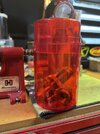So Hornady scales which likely aren't the problem. I didn't see what you were using for a powder measure or how often you checked the powder drop.
CFEpistol looks like it would run pretty good through a powder measure so I would check it every 10th to 20th drop.
Ok, i tumble this brass in a wet media tumbler with no additive. I then dry the brass in a Lyman brass dryer for 3 hours.
Next day i separate out 50 pieces into a loading tray. I then resize all 50 pieces in a single stage hornady press using an RCBS 9mm carbide die careful to drop each one in a Hornady case gauge checking for length and fit before returning it to a separate loading tray.
Then,,i bell each piece individually to the minimum amount to which the 124gn projectile will sit in the case mouth. Return the cases to the previous loading tray.
Next i prime each case with a Hornady hand primer with CCI 500 small pistol primers i bought at BassPro using the correct shell holder and inspect them individually for correct seat depth which should be slightly below the surface of the case base. The primed case are inserted into a separate loading tray in the inverted position so the primer is visible.
Next, i sit a sized, checked, belled, primed case on my warmed up and calibrated digital hornady scale and zero it to the case weight. After i pick up the case off the scale i note the value of the negative sum displayed by the scale.
I then charge the case with a hornady powder thrower equipped with the hornady pistol charge meter.
I return the case to the scale and measure the charge. If i see 4.7 i pick up the case an note the negative value displayed by the scale. If either the charge weight is incorrect or the displayed negative value has changed i dump the case and start over with a zeroed scale. If the charge weight is correct and the negative values match i put the case back in the loading tray. At this point it should be noted my reloading room is a constant temperature with humidity kept below or at 30%.
After all 50 cases are charged and in the loading tray i visually inspect them for uniform charges.
Next i seat the projectile using an RCBS seat and crimp die to the recommended coal of 1.150 +/- 2 thousandths.
In the hornady manual, it is recommended to use little to no crimp. As a bit of a safety measure im careful to use what i consider a little crimp. I have inspected and measured some factory cases at the case mouth to determine what anyone with a brain would consider satisfactory.
At this point i return to the case gauge for fitment and measure the coal with a calibrated caliper set to standard means of measurement.
Satisfied i have completed a round to every possible safe standard imaginable i repeat the process until i have 50 completed rounds.
My first 50 9mm rounds fired with no problem or signs of over pressure and averaged 1020-1050 fps using a Labradar chrono.
Satisfied with that success i eventually had 1000 loaded rounds ready to go.
Im not sure how many i shot before the first failure but fail one did.
And now, here i am, asking the internet,
“Could it be the 30 year old brass”?
Obtaining an answer has lead to more questions and speculation than answers unfortunately.
My initial route to an answer was just to duplicate the process in new brass and see for myself the results.
Note to self, always go with your gut…


